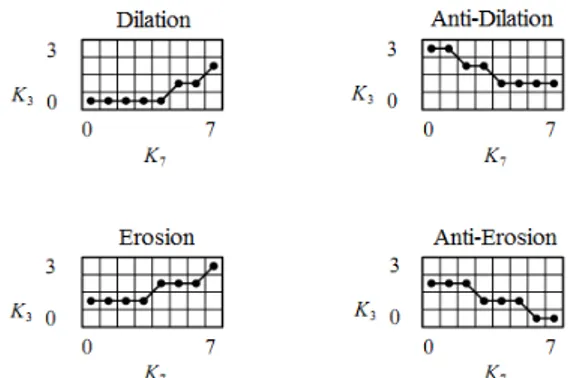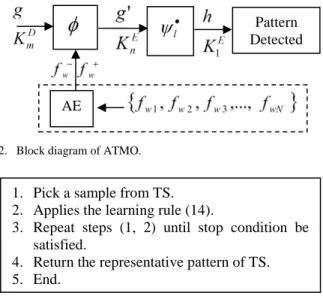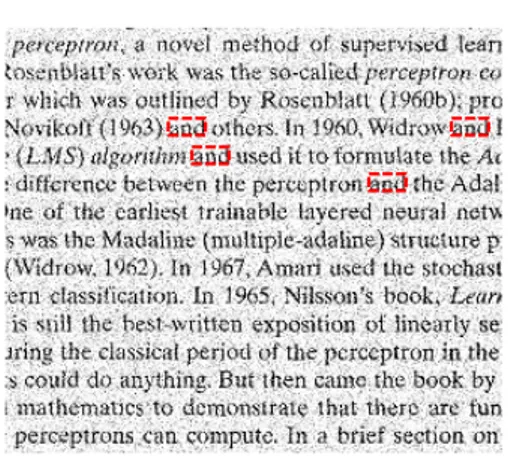Machine Learning And Adaptive Morphological
Operators
Magno P. de Almeida Filho
Dept. of Electrical Engineering Federal University of Ceará, UFCFortaleza, Brazil magnoprudencio@gmail.com
Francisco de A. T. F. da Silva
National Institute for SpaceResearch, INPE Eusébio, Brazil tavares@roen.inpe.br
Arthur Plínio de Souza Braga
Dept. of Electrical Engineering Federal University of Ceará, UFCFortaleza, Brazil arthurp@dee.ufc.br
Abstract—This work proposes the use of machine learning methods applied to the construction of a gray level adaptive hit-or-miss morphological operator. Because they are adaptive and translation invariant, it is expected that these operators can be better utilized for the process of pattern recognition. In a first approach, the investigated adaptive model is inspired on the Vector Quantization Unsupervised Learn Rule and developed through Elementary Look-Up Tables (ELUTs) formalism of elementary morphological operators in gray level images.
Keywords—mathematical morphology; pattern recognition; adaptive operator
I. INTRODUCTION
The researches towards building gray level Hit-or-Miss Transforms (HMT) have great appeal on pattern detection methods, particularly when applied to shape recognition or computer vision [1]. However, until the 1980’s, most applications were based only on binary images.
In the 1990's, some works, such as those developed by [1, 2], introduced the gray level Mathematical Morphology (MM) formalism suitable for the development of Hit-or-Miss Transforms. More recently, we can also verify other important contributions regarding other HMT formalisms as the one presented by [3].
In the MM literature, it is possible to find some works regarding the adaptive approaches of machine learning and morphological operators, as presented by [4], which implements adaptive MM operators with filters paradigms. It can also be observed some works that use hybridization paradigms between MM and Artificial Neural Networks (ANN), as shown by [5, 6].
In [6] is presented the main concepts from the simplest binary morphology to the most sophisticated morphology in gray levels and a framework to build neurons as adaptive morphological operators. In [7] is presented an introduction regarding the main concepts and formalism to build supervised adaptive morphological operators. However in [2] is presented a detailed introduction to gray level morphology ELUTs based.
In this approach, we consider the gray level formalism developed with Elementary Look-Up Tables (ELUTs), as presented by [2], as well as the hybridization between Kohonen learning rule and Hit-or-Miss operators based on the
sup-generating formalism, as presented by [1]. We are proposing an adaptive model that makes it possible to build adaptive template-matching operators for grayscale images.
The main idea is to build a morphological Hit-or-Miss adaptive operator considering a pattern set, or Training Set (TS), as a learning database applied to generalization for inexact matching. Here we are considering the pattern set as a class of small aspect variations from the same representative pattern from which we desire to perform detections. This adaptive engine will mainly show its importance when we need to realize detection in the real world.
In most case of real world, as for example, satellite remote sensing tasks, in general, when we observe two images of the same scene taken at different times or from different sensors, they are almost never equal [1]. Therefore, a template-matching engine can be better explored when it is based on inexact matching [8].
Considering the MM’s point of view, inexact matching can
be achieved by defining intervals around reference values and by testing if all the values of interest are falling into them [1]. Nevertheless, the requirement that all the conditions are satisfied is not reasonable in practice; a nice solution can be implemented by verifying that a minimum number of conditions are satisfied [1].
However, a practice way to find a good solution to represent the possible pattern variations to build one, and only one, detection operator is a very hard task to realize without considering an automatic engine applied to the adaptation of this operator.
In this paper, the main objective is to introduce an adaptive engine to build template-matching operators based on MM and Machine Learning paradigms defined within the framework of the lattice theory and, more specifically, the Mathematical Morphology as introduced by [1]. However, in this approach,
the “morphological correlation” is a sum of intersection
thresholds from adaptive templates.
generalize the way we process images regarding pattern detection tasks.
The paper is organized in the following way: in section II we present an introduction to Mathematical Morphology and how some elementary operators can be used in the pattern detection; in section III we present the learning rule applied to the Training Set for generalization of a particular class; in section IV we propose a new model of Adaptive Morphological Operator for template matching; in section V we present some experiments and preliminary results of the new operator; and finally, in section VI, conclusions and future research directions are presented.
II. MATHEMATICAL MORPHOLOGY
Originally, the Mathematical Morphology was based on singular transformations performed by two elementary operators, denominated by [9, 10] of dilation and erosion transformations. Subsequently, two other transformations, called anti-erosion and anti-dilatation, were introduced in [11]. However, the gray levels formalism of elementary operators defined from ELUTs can be found in [2].
The morphological model, defined from ELUTs, for image analysis is based on information extraction from images by transformations between lattices. A lattice is a partially ordered set in which the infimum and supremum of two elements and exists [12]. Let and be, respectively, the infimum and the supremum of two elements and in a lattice. In a finite domain, a finite lattice has a smaller and a greatest element that will be denoted respectively by and . Let and
be two finite lattices, , ,
, and be a mapping from to .
will be called operator, and by definition:
is a dilation
and
is an erosion
and
is an anti-dilation
and
is an anti-erosion
and
For any and in .
For the general case of a complete lattice, see [13, 14]. From the operators defined above, we can represent any operator (transformation) from to , as can be seen in [1]. Thus, these operators are known as elementary operators of the mathematical morphology.
Fig. 1 shows an example of elementary morphological transformations through ELUTs.
Fig. 1. Example of elementary morphological transformations through ELUTs [2].
From now we will describe some more sophisticated operators.
Let be the integer’s numbers set, the Cartesian product , (the images domain), (the images or patterns domain) called window, and the interval
(the gray levels images scale). We denote the
set of mappings from to . These mappings are mathematical representations adequate to gray levels images, with domain (pixels positions set) and gray levels scale , more details can be saw in [2].
Therefore, the digital images in this domain can be represented by elements from . If , and is equal to 1, so is a binary image, otherwise, is a gray level image.
Let (a pattern), and consider two integers , , where . We can define two images and
, on the following way:
Where .
These two images represent the intervals considered around the pattern to perform an inexact matching.
Let (the symbol represents a Minkowski
subtraction [15]), an integer number in and ,
where (number of elements of ). The
transformations from to denote by and operators can be defined by:
{
{
For any and .
We call template-matching operator, the operator from to , defined by:
∑
Where the are operators from to , given by:
The operators that performs intersections of an erosion and an anti-dilation, like , are called sup-generation [14]. These operators are similar to hit-or-miss operators for binary images.
The value of can supply a similarity measurement (kind of morphological correlation), between the pattern and sub-image slided by translated from , by matching condition. Details about by matching condition can be seeing in [1]. In case of sub-image be exactly , the similarity will be maximum value and equal to . If or , the model can perform a controlled inexact template matching, i.e., the matching concerns to percentage of , like presented in [6]. The percentage of needed to establish the matching condition will be called level of similarity.
The matching condition's value is used as a reference in a threshold operator. That way, the location of the sub-image will be known.
Let , the threshold operator from to can
locate the values of over or equal to (matching condition). This operator is defined by:
{
In fact, to get practical effect we should composite the threshold operator (11) with a template-matching operator (9), this composition (symbol ) introduce the Thresholded Template-Matching Operator (TTMO), like presented in [6], and it is defined by:
For a particular pattern be recognized by TTMO is used a level of similarity between 70% and 95% (depending on application).
III. REPRESENTATIVE PATTERN LEARNING RULE
To improve the response of the TTMO, instead of using a pattern of one class as reference, is used a representative pattern of the class. This representative pattern is estimated from a training set containing possible variations in the patterns of the class.
We can see the vector quantization learn rule as unsupervised density estimators or auto-associators [16], this interpretation is closely related to k-means cluster analysis [17].
The final weight or codeword corresponds to a cluster, the center of which is called a "Codeword Vector (CWV)". In this
work the Kohonen's learning rule is an algorithm that finds the CWV closest to the training case and this procedure define the CWV closer to the training patterns set. When the learning process finish the CWV represent all variations present on patterns set and is called representative pattern of the training set or class.
CWV is moved a certain proportion of the distance between the weight vector and the training case, the proportion being specified by the learning rates, that is:
–
Here we also can use and learning rates adapted from [17], that is:
where , , is the number of cases in the training set, is the representative pattern to be found, assumes in each epoch, and are the possible variations of the template to be trained.
The representative pattern of a particular class will be used as image search in Thresholded Template-Matching Morphological Operator. The training process of the representative pattern is called Adaptive Engine (AE).
The AE proposed is implemented by an algorithm applied to the construction of the representative pattern of a class. This algorithm uses a training set containing possible variations in patterns of class with a particular case of the Kohonen learning rule.
IV. ADAPTIVE TEMPLATE-MATCHING OPERATOR
The formalization of the proposed operator demands some definitions. Consider the functions (a) ,
(b) , (c) (d) and (e) ,
respectively, (a) the patterns of a same class in the training set, (b) the image to be processed (the input signal), (c) the representative pattern, resulting from adaptive engine, (d) indicates a kind of morphological correlation between and , and (e) resulting image from threshold operator, that locates in according to a predetermined matching condition. This matching condition is a percentage of the pixel count of the representative pattern (maximum value of morphological correlation).
So, we can define an adaptive transformation as the block diagram of Fig. 2. This transformation will be called Adaptive Template-Matching Operator (ATMO).
In the block diagram, Fig. 2, we can see the first two blocks above regarding to activation or final operation mode. That is the general mode of HMT works on patterns detection task. Additionally we have a dotted block regarding the learn process which is composite by the AE and a TS. The AE applies the procedure show in Fig. 3.
Fig. 2. Block diagram of ATMO.
Fig. 3. A simple training algorithm for vector quantization or AE.
V. EXPERIMENTS AND PRELIMINARY RESULTS
This section will present some preliminary results of experiments using ATMO.
For the experiments, images of the text of a book were extracted in ".jpg" format. Fig. 4 shows an example of extracted image.
The aim was to find in the image of Fig. 4 a representative pattern previously trained by AE and a TS. The pattern to be detected was defined as the image relating the word "and". In this case the training set consisted of models of word image "and" selected from other parts of the book, rather than the section shown in Fig. 4.
The parameters and presents in (5) and (6) are obtained experimentally, and can vary depending of the application. For this case the same value was used for both ( .
Another experimental parameter is the level of similarity between the image and the representative pattern to be detected. In this case, the level of similarity used was 81%.
Fig. 5 shows the final result of applying ATMO for the word image "and" detection in the image of Fig. 4.
Comparing with the TTMO proposed by [1] and [6] the ATMO proved more efficient. Fig. 6 shows the best result obtained by the TTMO when the patterns from the training set were used individually.
From Fig. 6 it is possible to see that only two occurrences of the word image "and" were found correctly. The TTMO operator incorrectly returned a portion of the word image "came".
The ATMO also proved robust to noise. Fig. 7 shows the results when a Gaussian noise was added to the search image.
Fig. 8 shows the final result of applying the minimum distance method for the word image "and" search in the image of Fig. 4.
An advantage of the ATMO over minimum distance method in this type of search is that the minimum distance method identifies only one pattern, the one that presents the shortest distance in relation to the representative pattern, as shown in Fig. 8. As in ATMO is defined a level of similarity, the subimages that are within this measure will be identified. Therefore, by ATMO is possible to identify multiple occurrences of a pattern within a search image.
Despite the presented advantages, the values of the level of similarity and constants and used in (5) and (6) are experimental and difficult to be asserted. These parameters also depend of the application.
Fig. 4. Image in ".jpg" format of the text of a book.
Fig. 5. Final result of ATMO search by word image "and". All patterns were found correctly.
AE
Pattern Detected
1. Pick a sample from TS. 2. Applies the learning rule (14).
3. Repeat steps (1, 2) until stop condition be satisfied.
Fig. 6. Best result of the TTMO search by word image "and".
Fig. 7. Final result of ATMO search by word image "and" with Gaussian noise added to the search image.
Fig. 8. Final result of minimum distance method search by word image "and".
VI. PARTIAL CONCLUSIONS AND FUTURE WORK
This work present an idea about the possibilities to development a morphological formalism for shape detection,
using Hit-or-Miss operator and machine learning paradigm inspired in vector quantization learn rule.
It was defined and detailed the Adaptive Template-Matching Operator (ATMO) as an alternative to be used in applications of pattern recognition in gray level images.
The ATMO proved effective in preliminary tests, but is still very dependent of experimental parameters such as level of similarity and constants and .
As future work, it is proposed to investigate methods that automate the choice of these parameters as part of the operator's training.
The hardware implementation of ATMO (e.g. FPGA) to perform pattern recognition tasks in real time can also be considered as a further work. This model could be used for tasks of pattern recognition in remote sensing via satellite, airplane or UAV (Unmanned Aerial Vehicle).
REFERENCES
[1] G. J. F. Banon and S. D. Faria, Morphological approach for template matching, SIBGRAPI'97, IEEE Computer Society, pp. 171-178, 1997. [2] G. J. F. Banon, Characterization of translation invariant elementary
morphological operators between gray-level images, Research report, INPE-5616-RPQ/671, INPE, São José dos Campos – SP – Brazil, 1995. [3] B. Naegel, N. Passat and C. Ronse, Gray-level hit-or-miss
transforms-part I: unified theory pattern recognition, Elsevier Science Inc., vol. 40, Issue 2, pp. 635-647, February 2007.
[4] F. Cheng, A. N. Venetsanopoulos, An adaptive filter for image processing, IEEE Transactions on Image Processing, vol. 1, no. 4., pp. 533-539, October, 1992.
[5] J. L. Davidson and F. Hummer, Morphology neural networks: an introduction with aplications, Circuits System Signal Process, pp. 179-210, 1993.
[6] F.A.T.F. Silva and G. J. F. Banon, Rede Morfológica não Supervisionada - RMNS. Doctoral thesis in applied computer science, INPE - São José dos Campos, 1998.
[7] F. A. T. F. Silva, Operadores morfológicos adaptativos, In: Congresso de Matemática e suas Aplicações, Foz do Iguaçu, Anais do Congresso de Matemática e suas Aplicações, pp. 1-2, 2006.
[8] L. G. Shapiro and R. M. Haralick, Structural descriptions and inexact matching. IEEE Transactions on Pattern Analysis and Machine Intelligence, 3(5):504–519, Sept. 1981.
[9] G. Matheron, Random sets and integrad geometry, New York: Wiley, 1975.
[10] J. Serra, Stereology and structuring elements, J. Microscopy, pp. 93-103, 1972.
[11] J. Serra, Thickenings, Thinnings. Centre de Morphologie Mathématuque, École Nationale Supérieure des Mines de Paris, June, 1987.
[12] G. Birkhoff, Lattice theory, 3rd ed., Providence, Rhode Island, American Mathematical Society, 1967.
[13] J. Serra, Image analysis and mathematical morphology, vol. 2: theoretical advances, London: Academic Press, 1988.
[14] G. J. F. Banon and J. Barrera, Decomposition of mappings between complete lattices by mathematical morphology – part I: general lattices. signal processing, 30(3):299-327, Feb. 1993.
[15] G. J. F. Banon and J. Barrera, Bases da morfologia matemática para análise de imagens binárias, 2nd ed., MCT/INPE, INPE-6779-RPQ/682, 1998.


